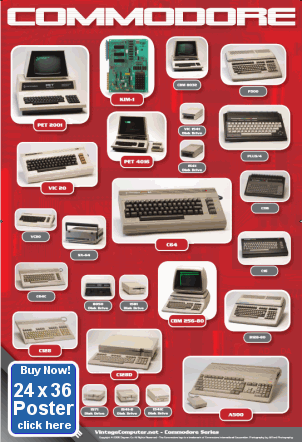 VC Blog | Contact
VC Blog | ContactFrom Giant Brains to Hobby Computers - 1957 to 1977
When one compares the Giant Brains article below with An Informal History of the Hobby Computer Market from the premier issue of Personal Computing he or she will certainly be impressed by the astounding rate of achievement during those 20 years.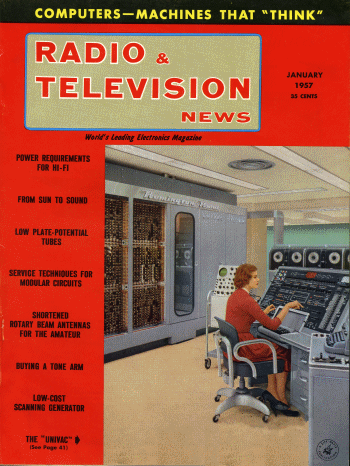
January 1957 Radio and Television News. "The UNIVAC" Computer. Click for larger image
Behind the Giant Brains
The January 1957 issue of Radio and Television News contains an early article covering the history of computing (up to late 1956) written by Frank Leary. Behind the Giant Brains tells the story of the post-war systems descended from the ENIAC and Mark I such as the UNIVAC and IBM 650, and also outlines some of the earliest milestones of the 19th and early 20th centuries. 1957 was in the midst of the large industrial computer era, including such systems as the IBM 650 "magnetic drum processing machine" and the Remington Rand UNIVAC System.
The author touches on the important concepts of how computers store information, analog vs. digital computers, and the significance of ENIAC's wiring panels vs. Mark I's papertape. The author correctly predicts that digital computers will eventually replace analog systems due to the former's potential for greater accuracy and flexibility. The Great Brains article gives today's reader a sense of how computers were perceived by the public in 1957, how they were used, etc.
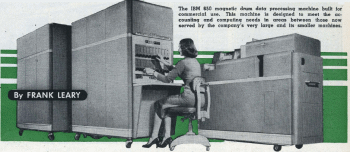
"The IBM 650 magnetic drum processing machine built for commercial use. This machine is designed to meet the accounting and computing needs in areas between those now served by the company's very large and its smaller machines."
".. ON A RAW afternoon in February, 1946, officials of the Federal government and the University of Pennsylvania, several luminaries of the world of science, and representatives of the press met at the Moore School of Electrical Engineering, on the University of Pennsylvania campus in Philadelphia.
Norbert Wiener, the MIT math professor who was to start a whole cross section of America using the term cybernetics, arrived characteristically without an overcoat. Others parked their wraps and were shown into a large room at the back of the building. Racks of electronic apparatus surrounded them. They were told they were inside an electronic calculator which could solve complex "differential" equations - such as an equation in external ballistics - faster than most people could state the problem. Some were excited, others politely interested, a few were bored. They watched the electronic gadgetry being put through its paces: punched cards with problem data were fed in, cards with answers were punched seconds later. Someone checked the results; they were correct. The press asked some questions, got some answers, and then everybody went to dinner.
These men had been summoned to witness the first public showing of the Moore School's electronic numerical integrator and calculator (a mouthful of description shortened by Army Ordnance officers into the acronym ENIAC).. It was not an occasion that seemed particularly world-shaking, but the outgrowths from this machine have been giving the world its share of shudders ever since. The whole pattern of our existence is being shaped by electronic computers, or "giant brains," to use Edmund C. Berkeley's much abused term. These computers can not only solve complex problems in advanced mathematics, but models now in existence can handle all kinds of information, from a payroll to the Bible. One, the Remington Rand "Univac," a lineal descendant of the ENIAC, was recently used by the Thomas J. Nelson Publishing Company to compile the Concordance for the Revised Standard Version of the Holy Bible. Other systems are gradually infiltrating our daily lives: our social security accounts, our insurance policy information, our income tax records, all are being converted onto files of magnetic tapes, which can be swiftly and efficiently processed by these automatic electronic computers..."
"..ENIAC, ... has been working around the clock at Aberdeen Proving Grounds ever since it was moved there in 1948. Another of the computer industry's grandparents sits where it was first built, at Harvard. This is the famous Aiken Relay Calculator Mark I, first of all truly automatic computers, built in 1944 by Harvard Computation Laboratories for the U. S. Navy. The two of them, different in concept but complementary to each other, have sired many progeny. Mark I was not electronic; ENIAC was. Mark I was automatically sequenced, which is to say, it was capable of automatically performing a series of instructions fed to it from punched paper tape; ENIAC recognized patterns of instructions set up in advance on wiring panels. Modern computers, which are generally both electronic and automatically sequenced, are logically descended from both "old" designs. .."
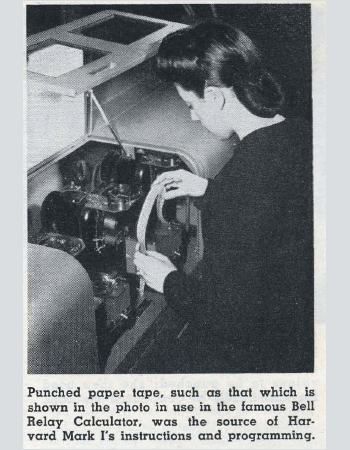
".. Mark I and ENIAC were both "war babies." Army Ordnance, trying to supply complete ballistic data on new weapons to Army field commanders, had pricked up its ears when John W. Mauchly, then an assistant professor on the staff of the Moore School, and now an executive of Remington Rand's "Univac" division, had suggested an electronic calculator as a possible solution; Ordnance funds sponsored the construction of ENIAC. Mark I, designed by Harvard's Howard Aiken and built by his staff in cooperation with International Business Machines Corporation, was fostered by the similar needs of Navy Ordnance. From these original wartime projects have sprung the burgeoning family of electronic digital computers -computers which recognize and electronically process actual numbers, or alphabetic characters, and not varying voltage levels, or turns of a cogwheel or gear or axle. The latter, called analogue computers, form a completely different family, with a somewhat similar heritage, but with different parents, and different uses. .."
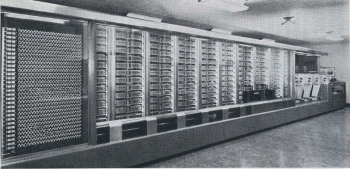
"All computing and processing of information in the Harvard Mark I was performed by means of high-speed relays."
"..Analogue computers possess two inherent limitations. First, they cannot easily be used for dissimilar problems. The computer itself is a mechanical or electrical analogy to an equation; changing the equation means changing the hardware of the computer. Second, they are generally only precise to two or three significant figures, depending on the fineness of construction; and their accuracy depends, not only on the accuracy of the input data, but also on the instruments which present the answers (calibrated oscilloscopes, meters, counters, etc.), and on the subjective "feel" of the operator who inspects these presentations. A digital computer can process ordinary numbers or alphabetic characters without any trouble at all. It can handle continuously variable data only by "digitalizing" it-sampling the value of the continuous function at regular time intervals and giving it a numerical representation - and then applying the methods of numerical analysis; but it can generally do far more types of work than an analogue computer, and, once the information is translated into discrete digital form, it never loses a decimal point of precision. Furthermore, the accuracy of the digital computer's work can easily be checked by inverse operations (proving addition by subtraction, etc.), by identical parallel operations compared for identical answers, or by many other means. .."
The author concludes with: ".. It is an error to romanticize, humanize, or personify these devices. They are completely unimaginative servants; they can do exactly what they are told, provided a tube doesn't burn out, and provided also that what they are told is consistent with what they can do; but they can do no more. They are controlled by the men who make them, the men who operate them, and the men who program them. They are. especially at the mercy of the men who turn them off when the day is through. Any time a computer seems to show imagination, it is because someone used imagination in designing its program. If a "giant brain" solves a problem, it is because someone (a) knew exactly how to go about solving that problem, and (b) knew precisely how to instruct the equipment in the procedures for solving that problem. If anyone ever gets one of these computers to write a symphony, for example, it will be because that person knows the laws of melody and harmony, counterpoint, orchestral placement, musical structure, and scoring, and knows what limits to set, and knows further how to translate all these laws, maxims, and principles into an abecedarian lingo that the simpleminded "brain" can follow. Anyone who can do that could write the symphony himself, in less time than it would take to get the computer to do it. The only advantage would be that the computer could turn out an infinitude of remarkably similar symphonies at an extremely rapid rate. .."
Click here to read the entire article including references to Babbage's engines, Herman Hollerith's electric counting machine used in the 1890 census, and the first die-set punch developed by Powers for the census of 1910, Mark I and ENIAC images.
An Informal History of the Hobby Computer Market
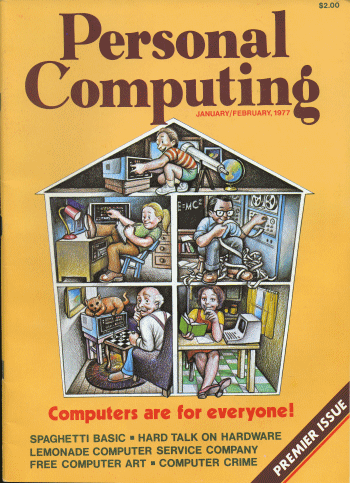
January - February 1977 Personal Computing. Click for pdf.
20 years later...
An Informal History of the Hobby Computer Market describes a lot of what happened after 1957. The whole concept of using computers as a hobby for "hacking" would have been almost unheard of in 1957. Here are some excerpts:
"..The hobby computer market was born in January 1975 when Popular Electronics ran a cover story on the MITS Altair 8800. Here's the interesting story of why that was the turning point and how the market has developed since then. .."
Origins (1963-1970)
Potential home experimenters (hobbyists) received their first tantalizing exposure to computers in the Sixties. The two most significant events during this period were (1) colleges installed timesharing terminals and instituted courses in BASIC and FORTRAN programming and (2) Texas Instruments Inc. introduced a series of integrated logic circuits (7400 TTL series) priced within range of electronics experimenters. .."
".. In 1967, Steven Gray of Darien, Conn. formed an Amateur Computer Society. By then a few hardy souls had succeeded in constructing rudimentary TTL computers with surplus core planes or "Rube Goldberg" mechanical memories. Still, no hobby computer market developed, mainly because system-level hardware costs were beyond reach of the amateur, though they dropped rapidly throughout the Sixties. For example, Digital Equipment Corp.'s first minicomputer, the PDP-5, was introduced in 1963 for $30,000. In 1965, DEC introduced its popular 12bit machine, the PDP-8, for what was then considered the incredibly low price of $18,000. By 1970, a basic PDP-8 configuration with 4K words of core was base-priced at about $10,000, but this price was above the amateur range. .."
The MARCH Digital PDP-8 Serial Number 1158. Click image for larger view.
The Pre-Market Period (1971-1973)
"..The disciplines and interests needed to create a base for the hobby market began to consolidate. The jelling point came in 1971, when Intel Corp. introduced the first microprocessor, the 4004. .. [and then] ... in 1972, Intel followed the 4004 with the 8008, an 8-bit (one-"byte") parallel processor. The 8008, with its ability to address 16K bytes directly, was even more significant. Though constrained by its 18-pin configuration and 8-bit data bus, it could take on many of the low-level tasks previously delegated to minicomputers in the way the 4004 could replace discrete logic. However, there were problems: it was expensive; its availability was uncertain; there was a severe shortage of knowhow; and a support IC, the 8229, was delayed in production.
The following year, 1973, Intel introduced the 8080. It was 10 to 100 times as fast as the 8008, more flexibly packaged (40-pin DIP), architecturally advanced (with internal address register, 16-bit program counter and stack register), addressed more memory directly (65K bytes), and possessed a larger instruction set (74 basic instructions vs. 48 for the 8008). .."
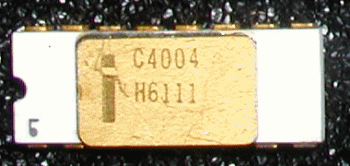
The original Intel 4004 microprocessor chip. Yes, those are gold pins.
Popular Software (1973-1974)
".. The potential was clearly building for a hobbyist market among both the software-oriented and the hardware oriented factions. On the software side, 1973 was a vintage year for the BASIC programming language. BASIC (for Beginner's All-purpose Symbolic Instruction Code) had been developed in the Sixties by John Kemeny and Thomas Kurtz at Dartmouth College, and for several years had been the preeminent language at schools. Almost every time-shared educational system contained a library of BASIC games and recreational graphics programs. In 1973, thanks largely to the efforts of Robert Albrecht, a West Coast computer "populist," and David Ahl, then at Digital Equipment, BASIC became the chief reason for non-students to want their own computers as well. .."
Popular Hardware (1974)
".. Some argue that the hobbyist market began in 1974 when at least three low-cost, 8008-based microcomputer kits were available. Unfortunately, none led to a popular market. One of them, however, the "Mark-8" , came close. The Mark-8 was as significant a factor in preparing the hardware base for a popular microcomputer market as David Ahl's games book and Bob Albrecht's People's Computer Co. were in exposing prospective hobbyists to software and recreational applications. The Mark-8 was designed by Jonathan Titus, a graduate student in chemistry at Virginia Polytechnic Institute. .."
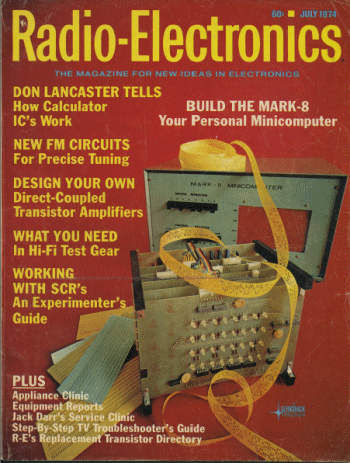
The Mark-8 "minicomputer" 1974
The Market Emerges (1974-1975)
".. Micro Instrumentation and Telemetry Systems, later known as MITS .. rushed to complete the design of what was to become the Altair 8800 by Christmas of 1974 and arranged with Popular Electronics to do a cover article. The article didn't appear until January 1975, which disappointed [MITS president Fred] Roberts, since he had been depending on Christmas mail orders for a large part of the 200-300 units he hoped to sell in 1975. As it turned out, that projection was too low by more than an order of magnitude. MITS 20 employees were soon deluged with orders for its $395 (later $439) kits and more greatly underestimated the market for a low-cost ready-to-run microcomputer. ... By the summer of 1975, orders from hobbyists were arriving at a rate that, according to MITS then-VP of Advertising, David Bunnell, on one Friday afternoon exceeded 300. .."
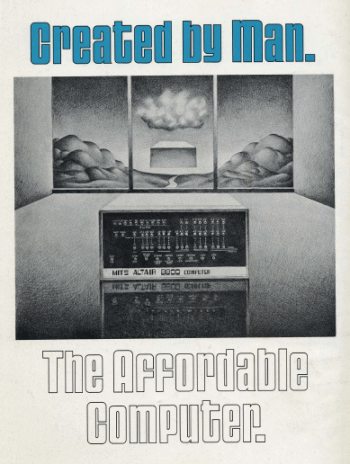
An early advertisement from Byte Magazine for the Altair 8800
A Clear and Present Market (1975-1976)
"..What had been an "emerging market" in the first half of 1975 became an "emerged market" in the second half. That summer the Computer Store Inc. opened. IMSAI [an Altair clone] was one of MITS' most unrelenting rivals. ... A MITS retail outlet, opened in Santa Monica and was soon followed by several non-affiliated retail stores.
The increasing popularity of programmable pocket calculators whetted appetites for more programming power. The IBM 5100 portable BASIC/APL computer, introduced in September for under $9000, further educated the public to the viability of the "home computer" concept.
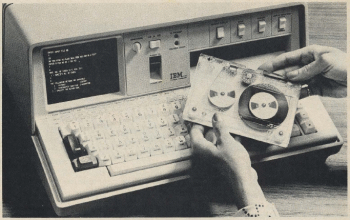
IBM's first personal portable computer, the model 5100.
The IMSAI 8080, like several others of the newer systems, was designed to be bus and PC compatible with the Altair 8800: a memory or interface board for the IMSAI 8080 also works in the Altair 8800. The cross-compatibility amounted to nothing less than a defacto standard, opening the door to any number of smaller firms capable of producing add-in memory, directly compatible peripherals and even alternate processor boards. In less than one year, the hobby computer market had evolved to the point of supporting a PCM (plug-compatible manufacturer) infrastructure at the board level. This development is as important as the original Altair announcement because it indicates the pervasiveness and staying power of this young industry. Indeed, the impetus it provides will extend far beyond the hobby market, and it will only be a matter of time before the machines that barely a year ago were considered novelties will be almost as ubiquitous as the CB radio, at least as much a fixture in the home as the microwave oven and as common in the small office as the editing typewriter. Their appeal is not merely that they are affordable but that they are understandable. They can be used by preschooler as well as professional and are limited in application only by the imagination. Today's hobby computer is nothing less than the leading edge of the consumer revolution. It cannot be ignored by any company presently serving the computer industry. The marketing question is no longer "should" but "how". .."
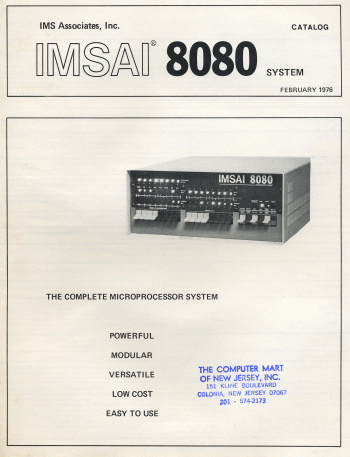
A brochure from IMSAI advertising their 8080 "clone" of the Altair 8800.
The Vintagecomputer.net Collectible Microcomputer Sleepers
A selection of classic computers that are less well-known but very rare and collectible. Comments?Past Issues:
On the Work Bench - Aug 2008
These are some of the computers and things that I am currently working on, or have recently picked up. Check my Vintage Computer Blog for updates, or post your questions.Interfacing an SWTPc 6800 using MP-S
Bob Grieb and Dan Roganti came by for some vintage hardware hacking, and we decided to try and interface an SWTPc 6800 with a Teletype model ASR 33. The SWTPc has an MP-S card installed.To start, the system was set to connect to a 300-baud terminal and it worked just fine. Why not take apart something perfectly good and *downgrade* the speed? Here are some pictures after completion of the project:
A printout from the Teletype model ASR 33. Click Image for larger version
SWTPc 6800 controller cards - two RAM cards in the front and the processor card with SWTBUG Prom. Click Image for larger version.
Click here for details and more pictures
YouTube Video
Commodore SuperPET (CBM SP9000)
This is one of the systems I plan to demonstrate at this year's Vintage Computer Festival East in September. This is going to be a software project, the theme will be PASCAL. The SuperPet has it's own version - Waterloo PASCAL. The interface is very easy to use. The SuperPet was poised for great things in 1981, prior to the IBM PC 5150 launch, but corporate turf wars and the C-64 distracted Commodore from dedicating more energy into the SuperPet.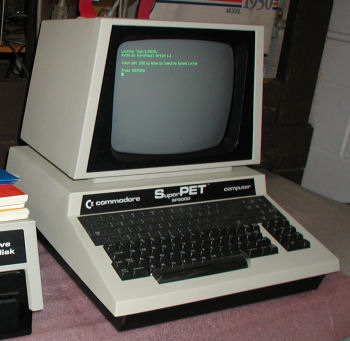
Commodore SuperPET boot screen. Click Image for larger version
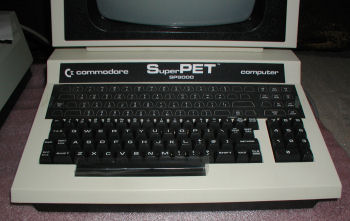
Close up of the keyboard and overlay map
Comments and pictures
IBM 5150 Restoration Project
I volunteered to restore the Mid Atlantic Retro Computing Hobbyist's non-functional IBM PC, for the Vintage Computer Festival / MARCH Museum Grand Opening exhibit this fall. This is an early "A" model 5150 with the 16K-64K motherboard and black power supply. These are very hard to come by. Through process of elimination, I found and replaced two bad RAM 4116 chips. I also replaced the bad monochrome display card.If you're troubleshooting an IBM PC, be sure your switch settings are correct AND that you're referencing the correct motherboard. There are two types 16K/64K and 64K/256K.
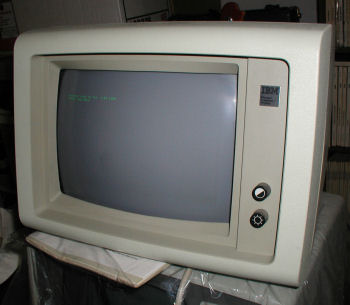
The IBM Personal Computer Display, model 5151.
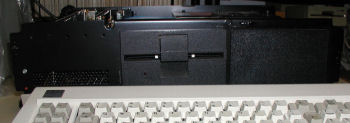
The IBM 5150 Personal Computer, serial number 0192592, Rev A. View of the chassis from the front, note the single disk drive. More Images
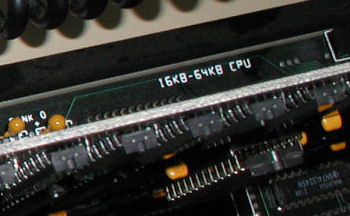
Closeup of the 5150 rev A 16K - 64K marking on the motherboard, found near the internal speaker. More Images
IBM PC BASIC C1.00 Boot Screen using CGA display.
IBM PC DOS 1.1 Boot Screen using CGA display.

Attempting to boot the IBM PC with CP/M 86. System with original monochrome display.
Step by step restoration details, comments, and more pics
Yet another IBM 5150 rev "A" restoration and pictures
How to extract an IBM PC 5150 BIOS Dump using debug.com
Using Debug commands, you can extract the IBM PC 5150 BIOS. I generated three BIOS dumps that you can download. The numbers associated with these files correspond to their IBM 5150 serial numbers.
Click here for How-To Thread
MITS Altair 8800b TURNMON
Thanks to Bob Grieb and Herb Johnson for hardware repair / tutoring. The LS73 chip in position T on the MITS TURNMON board was swapped by the original owner with a socketed set of jumpers permanently tying to power and ground. I was told that this means that it'd have a Q and Q bar output. When we attempted to run the turnkey program, we got a single carriage return to the monitor and then the program crashed. After careful inspection of schematic Bob/Herb decided that this modification should be removed, and replaced with a 74LS73, as indicated by the schematic.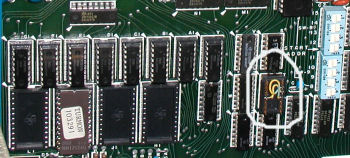
The MITS Altair 8800b Turnkey TURNMON card, closeup of the PROM, the mod in position T (circled), and the start address jumpers.
I ordered an 74LS73 and replaced the jumpered socket with the chip from the schematic. That was the last fix needed to complete the restoration, but at the time I did not realize it. I still needed to learn more about how the MITS 88-TPM serial interface worked, and properly interpret screen output. Memory dumps are in OCTAL and not formatted for RS232 output by default.
A screen shot of the MITS Altair 8800b Turnkey TURNMON prompt depicting some memory update actions.
View Entire Thread (esp. newest posts at bottom of page)
Sage II 68000 Computer
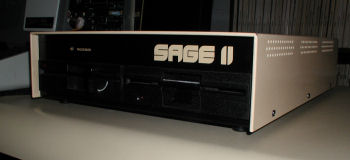
The SAGE II Computer. This is an early 68000 based processor system that pre-dates the Apple Lisa.
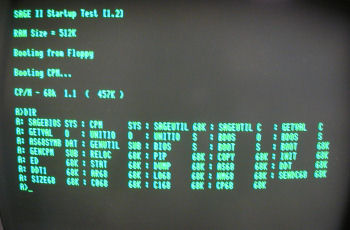
CP/M 68K boot screen
I have been able to boot both CP/M 68K and p-UCSD PASCAL with this unit, and access the BIOS which is set to interface with a Wyse-50 display terminal. The only thing I have not been able to accomplish is printing despite the fact that I have two of the printers described in the manual. I am missing SAGEUTIL and/or the proper parallel cable. The SAGE does not have a standard printer port. I have been in contact with David W. Erhart who runs a Stride/Sage web site for assistance. I plan to develop a demo application in UCSD PASCAL for the Vintage Computer Festival East 2008.
View Entire Thread and more pictures
AT&T 6300
The AT&T 6300 Computer with the optional diagnostic boot ROM option.
I cobbled together a system from spare parts, but it's 100% AT&T stock for the 6300, even down to the AT&T DOS disks. I had trouble with the display for a while, but it revived itself. When the system boots, the system runs Resident Diagnostics Rev. 1.21 at C800:0000.
NEC PC-6001A
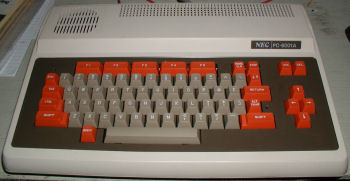
Orange Keys! NEC PC-6001A, among the first Japanese computers sold in the USA. Click image to view larger image.
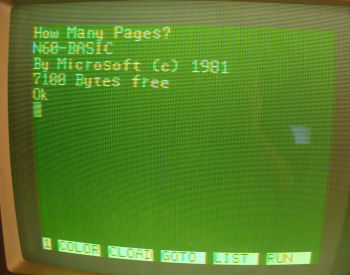
NEC PC 6001A BASIC
On the eve of the launch of the IBM Personal Computer in 1981, NEC began selling computers in the USA market. The PC-6001A is the first of the NEC computer models sold in the US. As part of research into Japanese computer companies of the early 80's, the NEC PC-6001A is of special interest. This system was a Z80 color computer, similar to the Tandy CoCo.
Entire Thread and Pictures
The Last HOPE 2008 - Osborne I Exhibit
I took an Osborne 1b ROM rev 1.4 to the 2600 magazine "The Last HOPE" convention on July 19th, as part of a vintage computer demo. I originally planned to exhibit an "original" version of the Osborne 1 (with the tan chassis, also model rev v. 1.4), but that one had a bad A drive. "Insert Disk in drive A and press RETURN" is as far as I could get.Osborne I, boot error
Prior to the event I did attempt to replace the drive. First I had to see what was going on inside of the machine. It takes about 10 minutes to completely disassemble an Osborne 1, if you have a longish phillips-head screwdriver. There are only three types of screws and clearly this machine was made for field repairs.
Anyway.. once I got the system completely apart so that I could get to the disk drives I learned that the drive gets it's 5v and 12v power from the data cable, and there is no separate power connector like your run-of-the-mill IBM PC drive. The drive's controller card had special electronics for drawing voltage through certain pins in the dataline, etc.
Classic Computing Items for Sale:
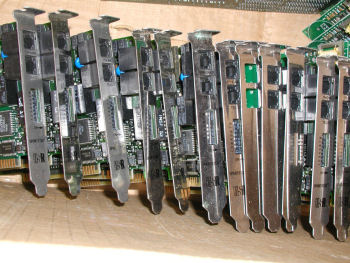
| CBM Commodore B Series Software (B-128 / CBM 700) | ||
| Superscript II Word Processor | $29.99 | |
| Superbase Database Manager | $29.99 | |
| Commodore Advanced Business Systems (CABS) Acccounting Suite: Accounts Payable, Order Entry, Accounts Receivable, General Ledger (4 binders) | $29.99 | |
| More CBM Commodore Items | ||
| Commodore B-128/700 Programmer's Reference Guide - Protecto - Everything you need to know about the B line! | SOLD OUT | |
| B Series Commodore Users Guide - View Image | $39.99 | |
| Commodore Users Guide Series 8000 | $39.99 | |
| Commodore BASIC Users Refence Manual Version 4.0 | SOLD OUT | |
| Commodore CBM Expansion Memory Board 64K Expansion Kit for PET 8032 (NOS) | SOLD OUT | |
| Commodore PET Keyboard (NOS) for 2001 -N, 3000, 4000 Series | SOLD OUT | |
| Other Commodore CBM Power supplies, software, parts, etc. | Contact Me | |
| Tandy Items | ||
| Aeoromp Double Density Controller for TRS 80 Model 1 Expansion Unit (NOS)- details | SOLD OUT | |
| Model III / Model 4 (non-gate array only) RS-232 KITS details | SOLD OUT | |
| Model III / Model 4 (non-gate array only) RS-232 boards only | SOLD OUT | |
| Model III Aerocomp Diskdrive controller | $39.99 (free US Ship) | |
| Looking for Something Else? | ||
| Please check here first with special requests for Commodore, IBM, Tandy, Atari, TI, Apple computers, parts, components, and software. I have systems plus zounds of miscellaneous items for sale or trade. | ||
